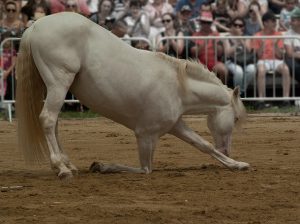
Horse Dressage Explained
Horse training lies at the core of the relationship man has with these magnificent creatures, and nowhere is this bond more prominent than with the horse dressage process. Horse dressage is a specialized training process aimed at showing the harmony between a rider and a horse. It was first recorded with the ancient Greeks and came to full prominence during the Renaissance as it was developed for the Cavalry.

The essence of horse dressage is training a horse to complete a series of predetermined movements from memory, so it is regarded by many as a sort of horse ballet dancing. Thanks to how much training is needed and how exciting it is to watch horses perform their routines, horse dressage became an Olympic sport which has many different international competitions and tournaments taking place every year.
As we have mentioned earlier, the critical thing about horse dressage is training. To get a horse to complete the movements or the so-called tests that judges rank at competitions with grades from 1 to 10, horses have to go through a rigorous training process based on some predetermined rules.
The following is an overview of what horse dressage includes and how the training process looks like.
Why Horse Dressage?

Horse dressage aims at showing the continuity of the horse’s movements without almost any signals from the rider. Dressage horses have highly developed physical and mental abilities and are capable of performing different sets of gaits, such as three-beat canters, trots, and four-beat walks.
Good dressage horses showcase the sense of style and prowess that resides in these animals and is put to prominence during their completion of routines and movements.
Not only does horse dressage improve the capabilities of horses, but it also affects trainers as well. Trainers develop greater patience and learn to better understand these animals.
How Do Trainers Train Dressage Horses?
The training process is a long one and takes step by step actions until a horse is able to perform all these movements without any or with minimal cues from a rider. The point is to get a horse to perform these actions under a saddle and with a rider on top. The learning process begins with getting a horse to feel accustomed to carrying saddles and riders. Then, some simple commands that have to do with canters, trots, and when to halt and when to move are learned. After these simple coordinated movements are determined, trainers then move on to more complicated lateral movements.

Usual training methods incorporated in the training process are positive and negative reinforcements. With the positive reinforcements, trainers establish some sort of a reward system for horses where they give them treats they like for every command or motion learned. It is a lengthy procedure that requires patience as it is not easy to trigger the kind of behavior you want from the horse, but it is seen as a more humane method than the other one named negative reinforcement.
The negative reinforcement includes applying physical pressure and aversive treatment on horses until they complete the movement. This approach shouldn’t be taken lightly because it can lead to fear and anxiety in horses, although the tradition of breaking horses into obedience is the predominant one.
